| リュクサンブール公園 | |
|---|---|
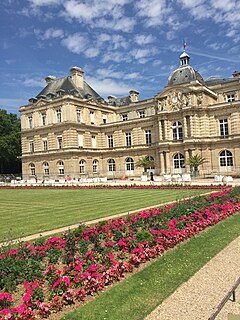 | |
| 所在地 | |
| 面積 | 22.45ha |
| 開園 | 1612年 |
| 設計者 | ジャック・ボワソー |
| 設備・遊具 | リュクサンブール宮殿ほか |
Jardin du Luxembourg
The Jardin du Luxembourg (French pronunciation: [ʒaʁdɛ̃ dy lyksɑ̃buːʁ]), also known in English as the Luxembourg Gardens, is located in the 6th arrondissement of Paris, France. It was created beginning in 1612 by Marie de' Medici, the widow of King Henry IV of France, for a new residence she constructed, the Luxembourg Palace. The garden today is owned by the French Senate, which meets in the Palace. It covers 23 hectares and is known for its lawns, tree-lined promenades, flowerbeds, model sailboats on its circular basin, and picturesque Medici Fountain, built in 1620.[1] The name Luxembourg comes from the Latin Mons Lucotitius, the name of the hill where the garden is located.[2]
History[edit]
In 1611, Marie de' Medici, the widow of Henry IV and the regent for the King Louis XIII decided to build a palace in imitation of the Pitti Palace in her native Florence. She purchased the hotel du Luxembourg (today the Petit-Luxembourg palace) and began construction of the new palace. She commissioned Salomon de Brosse to build the palace and a fountain, which still exists. In 1612 she planted 2,000 elm trees, and directed a series of gardeners, most notably Tommaso Francini, to build a park in the style she had known as a child in Florence.[3] Francini planned two terraces with balustrades and parterres laid out along the axis of the chateau, aligned around a circular basin. He also built the Medici Fountain to the east of the palace as a nympheum, an artificial grotto and fountain, without its present pond and statuary. The original garden was just eight hectares in size.[4]
In 1630 she bought additional land and enlarged the garden to thirty hectares, and entrusted the work to Jacques Boyceau de la Barauderie, the indendant of the royal gardens of Tuileries and the early garden of Versailles. He was one of the early theorists of the new and more formal garden à la française, and he laid out a series of squares along an east–west alley closed at the east end by the Medici Fountain, and a rectangle of parterres with broderies of flowers and hedges in front of the palace. In the center he placed an octagonal basin with a fountain, with a perspective toward what is now the Paris observatory.
Later monarchs largely neglected the garden. In 1780, the Comte de Provence, the future Louis XVIII, sold the eastern part of the garden for real estate development. Following the French Revolution, however, the leaders of the French Directory expanded the garden to forty hectares by confiscating the land of the neighboring religious order of the Carthusian monks. The architect Jean Chalgrin, the architect of the Arc de Triomphe, took on the task of restoring the garden. He remade the Medici Fountain and laid out a long perspective from the palace to the observatory. He preserved the famous pepiniere, or nursery garden of the Carthusian order, and the old vineyards, and kept the garden in a formal French style.
During and after the July Monarchy of 1848, the park became the home of a large population of statues; first the Queens and famous women of France, lined along the terraces; then, in 1880s and 1890s, monuments to writers and artists, a small-scale model by Bartholdi of his Liberty Enlightening the World (commonly known as the Statue of Liberty) and one modern sculpture by Zadkine.
In 1865, during the reconstruction of Paris by Louis Napoleon, the rue de l'Abbé de l'Épée, (now rue Auguste-Comte) was extended into the park, cutting off about seven hectares, including a large part of the old nursery garden. The building of new streets next to the park also required moving and rebuilding the Medici Fountain to its present location. The long basin of the fountain was added at this time, along with the statues at the foot of the fountain.
During this reconstruction, the chief architect of parks and promenades of Paris, Gabriel Davioud, under the leadership of Adolphe Alphand, built new ornamental gates and fences around the park, and polychrome brick garden houses. He also transformed what remained of the old Chartreux nursery garden, at the south end of the park, into an English garden with winding paths, and planted a fruit garden in the southwest corner. He kept the regular geometric pattern of the paths and alleys, but did create one diagonal alley near the Medici fountain which opened a view of the Pantheon.
The garden in the late nineteenth century contained a marionette theater, a music kiosk, greenhouses, an apiary or bee-house; an orangerie also used for displaying sculpture and modern art (used until the 1930s); a rose garden, the fruit orchard, and about seventy works of sculpture.[5]
盧森堡花園(Jardin du Luxembourg)
這個不太起眼的雕像,近看卻讓人吃驚,因為環繞在這孩童腳下的人像都是十九世紀法國藝文界的名人,音樂家如白遼士、佛瑞,小說家雨果等等.....
「盧森堡花園」(Jardin Du Luxembourg, Paris)跟西洋音樂史是有點關係的!音樂史上通常會把歷史上第一部Opera 的頭銜放在1600年,由Peri 跟Rinuccini創作的田園劇(pastoral drama)《尤莉迪琦》(L’Euridice) 上!而這齣劇,是為了翡冷翠麥迪契公爵((Duke of Medici)的姪女瑪麗(Maria de Medici)跟法國國王亨利四世(King Henry IV of France)的婚禮上演出的。劇情取自希臘神話「奧非歐到地獄救妻子尤莉迪琦」的故事。
當瑪麗嫁到巴黎後,國王亨利四世特別為瑪麗建造了這個「盧森堡花園」。因此這個公園裡除了有瑪麗的塑像以外,還有一些希臘神話中的人物、與故事。到了十九世紀後期,增加了很多法國當代出名的音樂家、小說家、哲學家,雕塑家等等…。白遼士、佛瑞、雨果的頭像都在園中。
***
盧森堡公園(法語:Jardin du Luxembourg)是一座處於巴黎第六區,拉丁區中央的公園,於1612年瑪麗·德·美第奇的統治下建成。盧森堡公園面積為224,500平方公尺,如今是巴黎學生、遊客聚集之地。
建築物與雕塑[編輯]
由一圈漂亮的鍍金圍欄圈著的盧森堡公園位於巴黎拉丁區的中心,其內包括:
- 盧森堡宮,法國參議院所在地。
- 盧森堡博物館,可供舉行一些臨時的大型藝術展會,以其參展作品的水平而聞名。盧森堡宮與盧森堡博物館由沃日拉爾路向連。
活動[編輯]
公園裡也舉行著不同的體育活動:網球,籃球,武術,以及法國每年九月第一個星期天的掌球錦標賽的決賽。參議院的掌球場曾經舉辦過1900年的夏季奧運會的活動。公園的西北角,接近橘園的地方,是下西洋棋的人,不論寒暑,經常聚會的場所,而橋牌玩家則更喜歡晴暖的天氣。
在公園周圍的圍欄上經常舉行著相片的展覽,而公園東北角的音樂亭時常是音樂會的舉行場所。公園內還偶爾演出歌劇。孩子們也有他們的活動:遊樂場,騎馬遊園和木偶戲。在公園中央的噴泉周圍,少年兒童經常玩遙控小船和放小帆船的遊戲。
公園的開放時間根據白天的長度而變:
- 開門: 7點30 到 8點15 之間
- 關門: 16點45 到 21點45 之間(以日落為限)

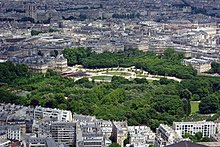


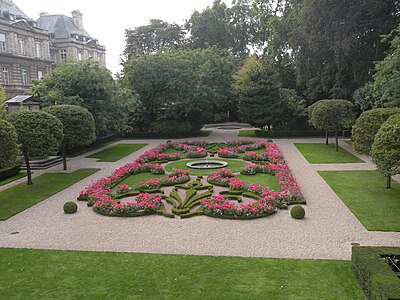
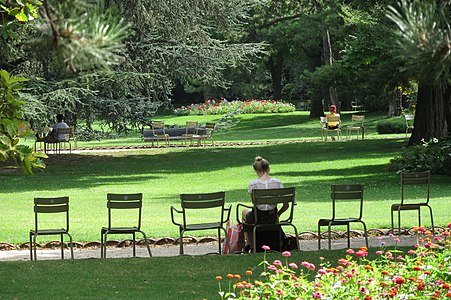
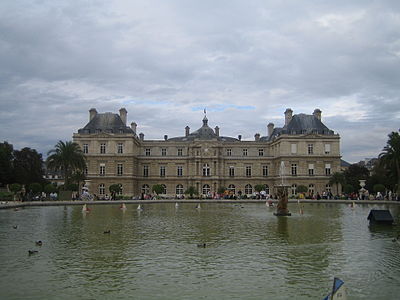





沒有留言:
張貼留言
注意:只有此網誌的成員可以留言。